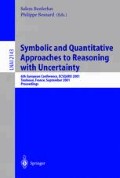Abstract
A (general) preferential entaulment is defined by a “preference relation” among “states”. States can be either interpretations or sets of interpretations, or “copies” of interpretations or of sets of interpretations, although it is known that the second kind and the fourth one produce the same notion. Circumscription is a special case of the simplest kind, where the states are interpretations. It is already known that a large class of preferential entaulments where the states are copies of interpretations, namely the “cumulative” ones, can be expressed as circumscriptions in a greater vocabulary. We extend this result to the most general kind of general preferential entailment, the additional property requested here is “loop”, a strong kind of “cumulativity”. The greater vocabulary needed here is large, but only a very simple and small set of formulas in this large vocabulary is necessary, which should make the method practically useful.
Access this chapter
Tax calculation will be finalised at checkout
Purchases are for personal use only
Preview
Unable to display preview. Download preview PDF.
References
H.L Arlo-Costa and SJ. Shapiro, ‘Maps between nonmonotonic and conditional logics.’, in KR’92, pp. 553–564, Cambridge, (1992). Morgan Kaufmann.
Alexander Bochman. An Epistemic Representation of Nonmonotonic Inference. Unpublished manuscript, 1999.
Alexander Bochman, ‘Credulous Nonmonotonic Inference’, in IJCau-99, ed., Thomas Dean, pp. 30–35, Stockholm, (August 1999). Morgan Kaufmann.
Tom Costello, ‘The expressive power of circumscription’, Artificial Intelligence, 104(1–2), 313–329, (September 1998).
Johan deKleer and Kurt Konolige, ‘Eliminating the Fixed Predicates from a Circumscription’, Artificial Intelligence, 39(3), 391–398, (July 1989).
Joeri Engelfriet, ‘Non-cumulative reasoning: rules and models’, Journal of Logic and Computation, 10(5), 705–719, (October 2000).
Sarit Kraus, Daniel Lehmann, and Menachem Magidor, ‘Nonmonotonic Reasoning, Preferential Models and Cumulative Logics’, Artificial Intelligence, 44(1–2), 167–207, (July 1990).
John McCarthy, ‘Circumscription-a form of non-monotonic reasoning’, Artificial Intelligence, 13(1–2), 27–39, (April 1980).
John McCarthy, ‘Application of circumscription to formalizing common sense knowledge’, Artificial Intelligence, 28(1), 89–116, (February 1986).
Yves Moinard, ‘Characterizing general preferential entaulments’, in 14th European Conference on Artificial Intelligence, ed., Werner Horn, pp. 474–478, IOS Press, 2000.
Yves Moinard, ‘Note about cardinality-based circumscription’, Artificial Intelligence, 119(1–2), 259–273, (May 2000).
Yves Moinard and Raymond Rolland, ‘Propositional circumscriptions’, TR INRIA 3538, Rennes, France, (October 1998). http://www.inria.f r/RRRT/RR-3538.html.
Yves Moinard and Raymond Rolland, ‘Preferential entaulments, extensions and reductions of the vocabulary’, TR INRIA-IRISA 3787, Rennes, France, (October 1999).
Yves Moinard and Raymond Rolland, ‘Characterizations of preferential entaulments’, TR INRIA-IRISA 3928, Rennes, France, (April 2000).
Yves Moinard and Raymond Rolland, ‘Smallest Equivalent sets for Finite Propositional Formula Circumscriptions’, in CL-2000, in LNau1861, pp. 897–911, 2000.
Donald Perlis and Jack Minker, ‘Completeness results for circumscription’, Artificial Intelligence, 28(1), 29–42, (February 1986).
Ken Satoh, ‘A Probabilistic Interpretation for Lazy Nonmonotonic Reasoning’, in AAau-90, pp. 659–664. MIT Press, (1990).
Yoav Shoham, Reasoning about change, MIT Press, Cambridge, 1988.
Author information
Authors and Affiliations
Editor information
Editors and Affiliations
Rights and permissions
Copyright information
© 2001 Springer-Verlag Berlin Heidelberg
About this paper
Cite this paper
Moinard, Y. (2001). General Preferential Entaulments as Circumscriptions. In: Benferhat, S., Besnard, P. (eds) Symbolic and Quantitative Approaches to Reasoning with Uncertainty. ECSQARU 2001. Lecture Notes in Computer Science(), vol 2143. Springer, Berlin, Heidelberg. https://doi.org/10.1007/3-540-44652-4_47
Download citation
DOI: https://doi.org/10.1007/3-540-44652-4_47
Published:
Publisher Name: Springer, Berlin, Heidelberg
Print ISBN: 978-3-540-42464-2
Online ISBN: 978-3-540-44652-1
eBook Packages: Springer Book Archive

